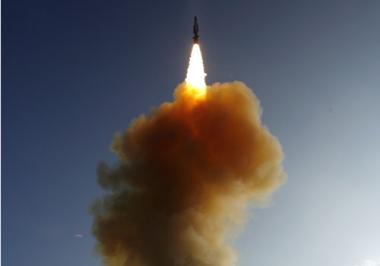Around the same time we East-coasters were bundled up, looking at the full lunar eclipse on Wednesday night, Feb. 20, another somewhat celestial event occurred: The U.S. Navy successfully shot down a "defunct spy satellite" with a missile launched from The USS Lake Erie, a modified cruiser stationed in the Pacific Ocean. While the navy's rationale seemed innocuous enough (to explode a fuel tank before it re-entered the atmosphere, where its hazardous contents might fall upon populated areas), many regard the incident as, rather, politically motivated.
Oddly enough, approximately one year ago, China shot down Fengyun-1C, an "ailing" weather satellite, with a ground-based military missile believed to have been launched from Xichang spaceport, the first time in history such a feat has been accomplished. According to NORAD, this event created 2,377 pieces of debris, making it the largest orbital debris-generating event on record. Bearing this in mind, the navy's operation seems more like a muscle-flexing response to China's actions, in what may quickly become another escalating arms race.
Noah Schactman's Danger Room, a respected source of technical information that's part of the Wired Blog Network, quotes several experts in the field who express a high degree of skepticism about the navy's explanation.
"Deputy National Security Advisor James Jeffrey said the satellite's tank full of hydrazine rocket propellant [which could create a cloud of toxic gas that could be dangerous if released over a populated area], was the main reason the military was planning to blast the orbiter," the website reported. According to several respected authorities, though, as well as Joint Chiefs of Staff Vice Chairman Gen. James Cartwright, the risk of such an event actually occurring were bordering on infinitesimal, and in fact, several other hydrazine-filled objects have already crashed into the earth with no ill effects, including debris from the ill-fated space shuttle Columbia.
"There has to be another reason behind this," Henry L. Stimson Center (an independent defense-oriented think tank) co-founder Michael Krepon told the Washington Post. "In the history of the space age, there has not been a single human being who has been harmed by man-made objects falling from space."
Chinese foreign ministry spokesman Liu Jianchao immediately called for the United States to release all relevant information pertaining to the event as soon as possible, and stated that "China is continuing to closely follow the possible harm caused by the U.S. action to outer space security and relevant countries." In defense of the U.S. action, Admiral Timothy Keating, head of the U.S. Pacific Command, noted that its action had, at least, been publicly announced, in contrast to China's.
"They just shot," he noted, "they didn't tell anybody about it."
Announced or not, it seems as if some sort of race is on. If we are to listen to those who are better informed than most on the subject, these incidents are not in any way random or coincidental. Rather, they are deliberate tests of the world's superpowers' anti-satellite or "ASAT" and (in the case of the U.S., the Bush-beloved) missile defense weapons systems. For those old enough to remember the Reagan-era equivalent, a multi-billion dollar failure dubbed "Star Wars" that was supposed to zap Soviet ICBMs out of the sky, look again—in the 21st century, the things Reagan dreamed of a quarter-century ago may not only be possible, but well on their way to becoming reality.



